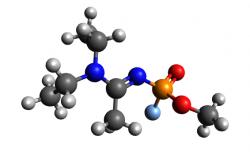Novichok: the deadly story behind the nerve agent

Against the backdrop of Salisbury’s beautiful cathedral, a new word recently gained global notoriety. But the three people who had the right to know most about Novichok, a nerve agent, were oblivious to its sudden appearance in headlines around the world – for they lay fighting for their lives in a British hospital.
Former Russian spy Sergei Skripal, 66, his daughter Yulia, 33, and police detective sergeant Nick Bailey, were all exposed to Novichok (or “newcomer”, to use its more parochial translation from Russian) in the English city on March 4. The circumstances surrounding the case are still being investigated – but the latest (unconfirmed and improbable) reports suggest that Skripal may have been exposed through the air vents of his BMW car.
Skripal was directly targeted, and perhaps his daughter was too, although it may simply have been Yulia’s proximity to her father that resulted in her exposure. Bailey was affected by the nerve agent as he was one of the first to respond and came into contact with it at a location as yet unknown. The police officer’s exposure is more likely to have been through contact with the nerve agent contaminating some surface.
At the time of writing, the Skripals remain in a critical condition in hospital. Bailey, meanwhile, is reportedly making a slow recovery and may be able to speak about his ordeal, perhaps providing vital clues. Environmental sampling will provide the evidence showing where the Skripals were most likely exposed and, hopefully, how that exposure occurred.
While the full facts have yet to come to light, the Novichok attack is developing into a full-blown international incident. The UK and Russia, which Britain has blamed for the attack, are now engaged in an increasingly bad-tempered tit-for-tat expulsion of diplomats.
The UK foreign secretary, Boris Johnson, even pointed the finger squarely at the Russian president, Vladimir Putin himself. Johnson said:
We think it overwhelmingly likely that it was his decision to direct the use of a nerve agent on the streets of the UK, on the streets of Europe, for the first time since the Second World War.
So how did we get here? And why do these lethal chemical agents exist at all?
The first nerve agents
The story stretches back to 1936, when the first nerve agent, named tabun (after the German word for “taboo”), was synthesised by talented German chemist Gerhard Schrader. Schrader was investigating organophosphate compounds for the Third Reich in an effort to find suitable insecticides to improve crop yields. He quickly discovered that tabun was too toxic to ever be used in farming as it would almost certainly kill those applying it. A year later, however, he developed a second, even more toxic nerve agent: sarin.
In debriefings by Allied intelligence officers after World War II, Schrader said that he’d been required to inform the Nazi authorities about his discoveries. But while Germany made munitions with both tabun and sarin, which were discovered at the end of the war, they were never used against Germany’s opponents.
Reasons for this are unclear. Some historians cite Hitler’s own exposure to chemical weapons during World War I and his apparent revulsion towards their use in battle. Others noteChurchill’s warning to Hitler that any use by Germany of chemical or biological agents would be met with a swift response. But the most convincing reason is likely to be the one mooted by Schrader himself.
Schrader noted in his post-war debrief that other scientists around the world, including in Britain, were working on organophosphate chemicals and believed that they were almost certain to have also discovered nerve agents. So if Germany used them, other countries would use them on Germany. In fact, Schrader was wrong; only Germany had the chemicals.
Going global
After World War II, however, the UK, US and Soviet Union gained access to Nazi chemical know-how – and many German scientists began working for the victors. At the time, the prevailing view was that chemical weapons would almost certainly be used in a future conflict, and so the military usefulness of nerve agents such as tabun and sarin was investigated.
But tabun and sarin had their limitations. They were well suited for use on a rapidly moving battlefront because they vaporised and broke down in contact with water and so would disappear rapidly after use. But this left a gap in the arsenal, so-to-speak, for more persistent, longer-lived agents.
These were developed in the UK in the 1950s and include the now well-known VX. This was the nerve agent used in the 2017 assassination of Kim Jong-nam, the half-brother of North Korean leader Kim Jong-un, in Kuala Lumpur airport.
Unlike sarin and tabun, VX-type agents, which have an oily texture and are very slow to evaporate, were considered to be what’s called area-denial chemicals. Any troops, or vehicles, moving through an area where VX had been used would have to be rigorously protected, compromising their manoeuvrability and fighting efficiency.
Nerve agents were evolving. But so too were the kinds of targets for chemical weapons. Increasingly, they were being used against civilians.
Who controls them?
About 20 different nerve agents have now been manufactured and all are listed, and restricted, under the 1997 Chemical Weapons Convention. Novichoks are an exception because they have never been declared, more on which later.
In World War I, before the arrival of nerve agents, it was primarily troops who were affected by chemical weapons. During that conflict, some 1.5m military casualties were exposed to irritants such as chlorine and phosgene, or the blistering agent mustard gas – and around 8-10% of those affected, died. Meanwhile, around 1,000 civilians were injured by chemical weapons during that war.
Since World War I, however, chemical weapons have been used by Italy in Abyssinia (now Ethiopia) in 1935-6; by Japan in China during World War II; by Egypt in Yemen between 1963 and 1967; by Iraq in Iran (1983-1988) and Kurdistan (1988); and between 2013 and 2017 by the Syrian government against its own people. Sarin was also used in a 1995 attack on the Tokyo subway by the Aum Shinrikyo doomsday cult, killing 13 and making thousands more ill. This is not a comprehensive list, but many of the victims of these attacks, particularly in Kurdistan and Syria, were civilians rather than troops.
Evidence of Iraq’s 1988 chemical attack on civilians in the Kurdistan town of Halabja, which included the use of sarin nerve agent, accelerated discussions already underway on a comprehensive chemical weapons treaty at the UN Council on Disarmament. In 1993, the Chemical Weapons Convention (CWC) was agreed. In 1997, the convention became international law following ratification of the treaty by 65 countries.
Today, 192 countries are fully paid-up members of the convention with only North Korea, Israel, South Sudan and Egypt still not part of the group. However, as the convention is international law, these four countries are still bound by its provisions that any use of a chemical to deliberately harm another person constitutes use of a chemical weapon – and is illegal.
The Organisation for the Prohibition of Chemical Weapons (OPCW) oversees implementation of the Chemical Weapons Convention and supervises destruction of declared chemical weapons and any production facilities for these weapons. To date, approximately 96% of declared stockpiles have been destroyed. In October 2017, Russia announced that it had destroyed its stocks of some 40,000 tonnes. The US is expected to complete destruction of its weapons stockpile by around 2021-2022.
In addition to supervising the destruction of stockpiles, the OPCW operates a control regime for chemicals that are either chemical weapons or could be used to make them. Every year, each signatory to the convention is required to provide the OPCW with details on the location, manufacture, use, sale or disposal of these substances. The OPCW audits these returns and verifies them by random annual inspections of hundreds of military bases and chemical companies around the globe.
All manufacturing programmes which resulted in stocks of chemical weapons exceeding one tonne per year after January 1, 1946 must be declared to the OPCW. But on March 16, 2018, the OPCW announcedthat it had never been notified about Novichok-type nerve agents by any state.
So what is Novichok and what does it do to its victims?
Novichok family
There is no doubt that nerve agents similar to the Novichok family exist, something that has been described by defectors from Russia. One of these was used to poison the Skripals and Bailey.
Nerve agents, including certain Novichoks, are part of the family of organophosphate compounds – albeit at the most toxic end of the spectrum. They all operate in a similar way by inhibiting the enzyme acetylcholinesterase (AChE). The enzyme can be found in various locations in the body, but it’s at the junctions between nerves and muscles where its activity is most critical. AChE regulates the message from nerve to muscle by inactivating the neurotransmitter acetylcholine.
Acetylcholine binds to receptors at the neuromuscular junction, instructing the muscle to contract. The enzyme then removes this messenger, splits it in two, and with its removal from the receptor the muscle relaxes. This cycle is repeated as often as required by the demands on the muscles.
Inhibition of this removal and cleavage process sends all muscles into spasm and they no longer function normally. The effects are wide-ranging with the most critical being on lung and heart function. Respiratory paralysis is common in severe poisoning and the resulting lack of oxygen to critical organs, such as the heart and brain, can have serious consequences. If untreated, it may be fatal.
Exactly where, when and by whom these chemicals were made, however, and how and who used them against the Skripals remain unclear, triggering a major international crisis.
The UK is now exercising its rights under the CWC and has asked the OPCW to investigate Russia’s so-called Novichok programme. This is the first time one party to the CWC has accused another of attacking it with a chemical weapon. It will be a major challenge for the OPCW, which has been invited to send inspectors to the UK to collect samples for testing. The OPCW will use its own laboratory in Rijswijk, next to The Hague, and perhaps one of some 20 other designated facilities around the world to confirm the exact identity of the nerve agent.
Once it is confirmed, the OPCW will endeavour to find out more. However, it has never pointed the finger of blame at a user. Its remit is to confirm the use or identity of chemical agents and it can be called upon to carry out inspections in countries accused of using one. Others, such as the UN, will then assess the evidence and do the finger pointing. This is what happened when Syria was accused in 2017 of using chemical weapons against its own population.
The CWC does not preclude bilateral action by its signatories – and Britain and Russia have already begun expelling each other’s diplomats over the row. Russia has also closed the British Council and a UK consulate in St Petersburg.
On the ground
But what of the situation on the ground in Salisbury, where the Skripals were attacked? Nerve agents can poison somebody though inhalation, ingestion or skin contact which is why investigators in Salisbury are wearing full protective clothing and gas masks.
In fact, it is now the investigators, rather than the public, who face the risk of sustained exposure to any contamination. Some 130 people have so far been identified who may have been in contact with the agent but none beyond the Skripals and Bailey have shown any symptoms.
It was reported that the Skripals were essentially comatose when discovered and so were unable to say how they felt. But paramedics would likely have found the couple struggling to breathe. They may also have noticed twitching muscles, a glassy appearance to the eyes with pinpoint pupils and profuse salivation. In hospital, there may have been evidence of increasing fluid build-up in the lungs, and their heart rates may either have been rapid or slowed, and uneven.
Effects on the brain would be less evident as the couple were unconscious, but can include restlessness, headache, confusion and convulsions. A part of the brain is concerned with regulation of respiration and this may be affected directly, slowing breathing. A fall in blood pressure is also likely.
Possible treatments
Antidotes to reverse the clinical effects of nerve agents are available and are more likely to be successful if administered early. Around 200 cases of less severe accidental poisoning and four severe ones have been reported since 1948.
In all of the severe cases, the person poisoned lost consciousness and breathing was inhibited. But prompt treatment by doctors who were nearby and aware of the potential for exposure resulted in the victims’ full recovery.
In a quirk of fate, the UK’s own defence teams against chemical weapons are located at Porton Down, just outside Salisbury. Indeed, there have also been tests on hundreds of military servicemen with small doses of nerve agents and in 1953, after one poorly conducted test in the UK, a 20-year-old leading aircraftman, Ronald Maddison, died. The 2004 inquest into his death returned a verdict of unlawful killing. It’s also claimed that in the Novichok programme one person was accidentally exposed and died.
Treatment can include the rapid administration of atropine. This blocks the effects of acetylcholine accumulation by occupying the same receptors and reverses some symptoms, but has little effect on skeletal muscle. The rule of thumb is to maintain dosing of atropine (at intervals) until the heart rate is over 90 beats per minute. Administration may be necessary for a significant period.
Drugs known as oximes can also be used as an antidote. These restore enzyme activity and, crucially, skeletal muscle function. But oximes tend to be specific for certain types of nerve agent and it is unclear which would work with the specific Novichok agent as there is little information in the public domain about them or their effective treatments. Faced with this dilemma, the clinicians treating the Skripals and Bailey would have had to have made a choice.
A third drug used in nerve agent poisoning is diazepam, which can prevent any dangerous convulsions which might occur. Regrettably, however, evidence indicates that severe nerve agent poisoning can cause long-term irreversible changes in brain function.
Nerve agents are grotesque weapons and their use against civilians is a deeply disturbing trend. But in the weeks to come, there will have to be a dispassionate review of the evidence. And as the spat between Russia, and the UK and its allies worsens, cool heads will be needed.
Amid all this frenetic activity, however, we must not forget the three victims – and wish them a swift recovery. After all, they are the ones paying the heaviest price.
Alastair Hay, Professor (Emeritus) of Environmental Toxicology, University of Leeds.
This post first appeared on:
Image credit: ChiralJon via Flickr (CC BY 2.0)


